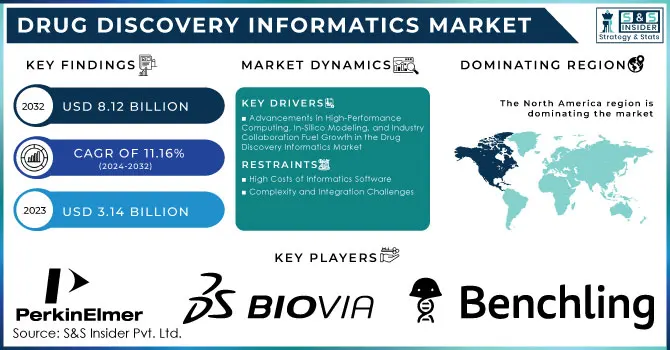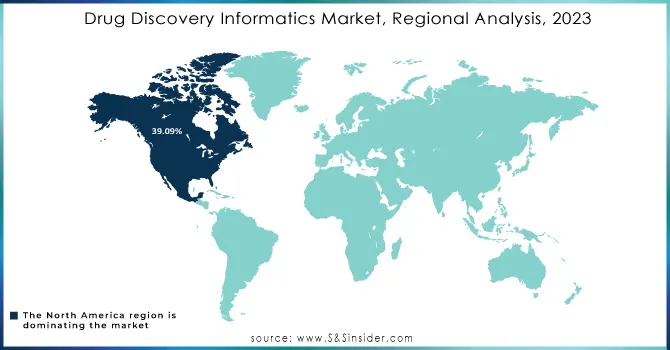Drug Discovery Informatics Market Report Scope & Overview:

Get more information on Drug Discovery Informatics Market - Request Sample Report
The Drug Discovery Informatics Market size was valued at USD 3.14 billion in 2023 and is expected to reach USD 8.12 billion by 2032 and grow at a CAGR of 11.16% over the forecast period 2024-2032.
The global drug discovery informatics market is experiencing robust growth because of development in high-performance computing and an increasing number of demands for innovative molecules of drugs. Other factors of this growth include an expanded volume of drug discovery data and more intense market competition. For instance, in 2021 the company, Certara, Inc., brought out the latest version of the PBPK Simulator - Simcyp Physiologically-based Pharmacokinetic (Simcyp PBPK), designed with newly added models on pregnant and lactating women drug interactions. These innovations will thus optimize how drug safety and efficacy may be enhanced toward a heightened impact on informatics.
In integration solutions such as Curve Therapeutics Ltd. selecting the CDD Vault to manage its data, timelines for discovering drugs are greatly streamlined in an environment where data sharing collaboratively between pharma, biotech, and academic groups is securely conducted. This is important because it emphasizes the market amid the existing impacts of COVID-19 that have pushed the demand for in silico tools and virtual screening methodologies to search for efficacious treatment. Companies have also been developing platforms that are tailored to COVID-19 research, for instance, IBM created the visual molecular explorer platform that aids in the study of molecules that target the SARS-CoV-2 virus.
It involves a driving force in precision medicine that allows for individually designed treatments based on their respective genetic or molecular profiling. Data solutions capable of managing vast databases, processing, and analytical methods have increased exponentially and in large numbers, contributing toward expansion in data as well as drug development costs are significant in this regard while using data analytics to increase minimization of errors helps to reduce timelines further in boosting the market.
The other driving forces in this market include a global increase in research expenditure for informatics by pharmaceutical and biotechnology companies, with rising interest in rare disease and orphan drug research. For this reason, the market offers a comprehensive range of tools to enable data gathering, processing, and visualization. Regional companies have been emphasizing joint research initiatives; however, growing needs to speed up the development of new medications and higher costs of IT infrastructure for healthcare also play a crucial role in fueling this market. Overall, the drug discovery informatics development process is transforming drug development efficiency, and growth in this market will further accelerate within the next few years.
Market Dynamics
Drivers
- Advancements in High-Performance Computing, In-Silico Modeling, and Industry Collaboration Fuel Growth in the Drug Discovery Informatics Market
The drug discovery informatics market is significantly driven by the growing interest in discovering drugs through informatics software and the improvements that are being made in high-performance computing and web services. The demand for in-silico modeling tools is increasing along with the increase in demand for new drug molecules, but the very high price for informatics software sometimes restrains this growth significantly. Simultaneously, growth in the expanding biotechnology and biologics sectors, particularly in emerging markets, provides vast business opportunities.
The market increases as advanced IT applications drive the competition between entities in the drug discovery market. For instance, in 2021, Certara, Inc. released version 20 of its Simcyp Physiologically-based Pharmacokinetic (PBPK) Simulator. It has models quantifying drug actions during pregnancy and lactation—critical decisions on optimizing medicines' safety and efficacy.
The adoption of informatics solutions by companies is also becoming a trend to hasten and streamline the process of drug discovery. Curve Therapeutics Ltd. is using CDD Vault for the secure management of data related to its genetically encoded Microcycle platform that promotes real-time data sharing and collaboration between the pharmaceutical, biotech, and academia sectors.
In addition, the continuous efforts in COVID-19 drug discovery have also expanded the market size. Scientists are using in silico tools and virtual screening to identify drug candidates that target viral proteins and ACE2 receptors. Platforms like IBM's Visual Molecular Explorer facilitate research by providing AI-generated models to optimize potential COVID-19 treatments, further strengthening the market.
Restraints
-
High Costs of Informatics Software
-
Complexity and Integration Challenges
Key Segmentation
By Workflow
The workflow segment accounted for approximately 40.0% share of Discovery Informatics, the largest share in that category. This is primarily because this segment is essential to early-stage drug research where high-throughput screening, genomics, and bioinformatics are used to increase the speed of potential candidates being identified. Increasingly, the volume of genomic and proteomic data with more sophisticated tools in analyzing such data has created more demand for discovery informatics. Moreover, the growing interest in precision medicine and the necessity of streamlining R&D processes has further strengthened this segment in the market.
Biocontent Management is likely to emerge as the fastest-growing workflow segment. This is due to the need for strong data storage and retrieval systems to manage and integrate large datasets, including gene sequences, protein structures, and clinical trial information. It is crucial for the pharmaceutical industry and research institutions that are increasingly focusing on implementing collaborative and data-accessible biocontent management solutions for modern drug discovery workflows. The compound annual growth rate (CAGR) for this segment is approximately 12.0%.
By Services
Sequence analysis platform dominated the services category with a share of nearly 35.0% in 2023. Because of the critical functions in genomics and next-generation sequencing analysis from which researchers could find genetic markers and possible drug targets. Growth in precision medicine also has been based on sequence analysis platforms for personalized treatment, thus solidifying dominance for this segment. Since they improve the precision and speed of genetic data analysis, these technologies have become a part of drug discovery and have gained adoption recently.
The services category is the fastest-growing segment by molecular modeling, which is estimated to grow at around 15.0% CAGR over the forecast period. The growth in this area is due to the growing applications in drug design and structural biology, as molecular modeling software simulates the molecular level of interactions of a drug. The growth is due to more and more companies using computational chemistry and machine learning tools. These tools have improved the predictability of molecular modeling at the molecular level regarding the efficacy of drugs and the reduction of time-to-market. With the focus placed on developing innovative drug molecules, molecular modeling services have gained a lot of demand.
Regional Analysis
North America held the highest share in the market revenue account, with 39.09% in 2023, because of the efforts being put into research and development concerning drug discovery. Advances in data mining, as well as analytics tools, do support drug discovery and drug development processes in North America, leading to a significant increase in their revenue market share account to contribute significantly to that overall revenue. Advanced informatics tools and techniques help extract valuable insights from the information, thereby helping researchers and pharmaceutical companies in deciding to speed up drug discovery and development. In addition, global efforts to expedite COVID-19 drug discovery have added momentum to the market in this region. Several companies have come up with specific web services and solutions developed for each stage of COVID-19 drug development. As a result, in June 2020, the molecule-targeting SARS-CoV-2 analysis of IBM's Visual Molecular Explorer involved open-source AI-generated artifacts for conducting early-stage optimization on the potential treatments. Besides, the North American companies have been recently very actively involved in joint ventures and collaborative research, which further drives the market growth. In December 2020, A2i Therapeutics announced that it would enter a joint venture with Atomwise, a leading AI-driven small-molecule drug discovery company, as well as with FutuRx, further increasing its portfolio of collaborative research. These research fields are spread over oncology, immunology, infectious disease, neuroscience, as well as clotting disorders. This requires significant growth in drug discovery informatics and propels the overall market.
On the other hand, the Asia-Pacific region is expected to grow with the highest CAGR at 11.9% during the forecast period. Pharmaceutical and biopharmaceutical industries are being expanded at a rapid growth rate while a growing number of contract research organizations also support such growth. China and India, among others, have been more in the limelight in their growth possibilities because of a significantly more developed infrastructure in drug development and discovery that is promoted through a good pipeline of skilled professionals and cost structures.

Need any customization research on Drug Discovery Informatics Market - Enquiry Now
Key Players
-
Schrödinger (Maestro)
-
PerkinElmer (Signals Notebook and ChemOffice)
-
BIOVIA (Dassault Systèmes) (BIOVIA Discovery Studio)
-
Benchling (Benchling Platform)
-
Genedata (Genedata Screener)
-
Thermo Fisher Scientific (Thermo Scientific Compound Discoverer)
-
Dotmatics (Dotmatics Platform)
-
Aragen Life Sciences (Drug Discovery Informatics Solutions)
-
GVK Biosciences (GVK BIO) (GVK BIO Informatics Solutions)
-
Molecular Discovery Ltd. (MoKa)
-
Lhasa Limited (Derek Nexus)
Recent Developments
In February 2023, Insilico Medicine, a clinical-stage company specializing in generative AI-driven drug discovery, announced it had received FDA Orphan Drug Designation for its AI-discovered and AI-designed treatment for Idiopathic Pulmonary Fibrosis.
| Report Attributes | Details |
|---|---|
| Market Size in 2023 | US$ 3.14 billion |
| Market Size by 2032 | US$ 8.12 billion |
| CAGR | CAGR of 11.16% From 2024 to 2032 |
| Base Year | 2023 |
| Forecast Period | 2024-2032 |
| Historical Data | 2020-2022 |
| Report Scope & Coverage | Market Size, Segments Analysis, Competitive Landscape, Regional Analysis, DROC & SWOT Analysis, Forecast Outlook |
| Key Segments | • By Workflow (Discovery Informatics, Biocontent Management) • By Services (Sequence Analysis Platform, Molecular Modelling, Docking, Clinical Trial Data Management, Others) |
| Regional Analysis/Coverage | North America (US, Canada, Mexico), Europe (Eastern Europe [Poland, Romania, Hungary, Turkey, Rest of Eastern Europe] Western Europe] Germany, France, UK, Italy, Spain, Netherlands, Switzerland, Austria, Rest of Western Europe]), Asia Pacific (China, India, Japan, South Korea, Vietnam, Singapore, Australia, Rest of Asia Pacific), Middle East & Africa (Middle East [UAE, Egypt, Saudi Arabia, Qatar, Rest of Middle East], Africa [Nigeria, South Africa, Rest of Africa], Latin America (Brazil, Argentina, Colombia, Rest of Latin America) |
| Company Profiles | Schrödinger, PerkinElmer, BIOVIA, Benchling, Genedata, Thermo Fisher Scientific, Dotmatics, Aragen Life Sciences, GVK Biosciences, Molecular Discovery Ltd., Lhasa Limited. |
| Key Drivers | • Advancements in High-Performance Computing, In-Silico Modeling, and Industry Collaboration Fuel Growth in the Drug Discovery Informatics Market |
| Restraints | • High Costs of Informatics Software • Complexity and Integration Challenges |

